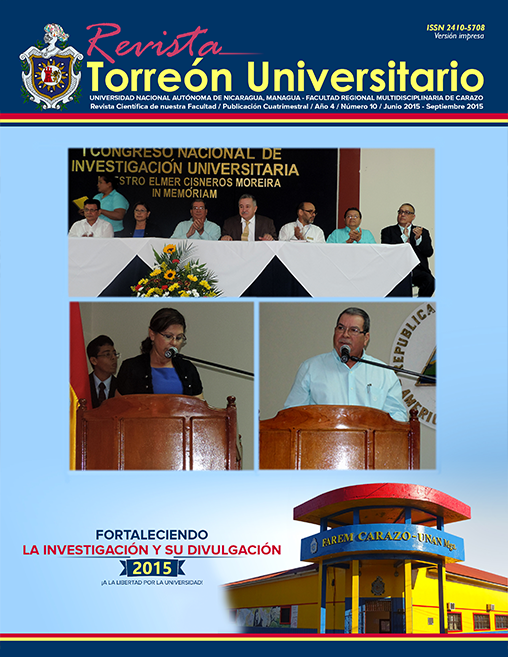Contextualize videos implementation as an innovative didactic strategies to develop the English speaking ability in 9th grade students of Manuel Hernandez Martinez’ institute, evening turn, on the second semester 2014
Abstract
English language has become an important universal language for communication indifferent areas in our society, therefore learning it requires the implementation of innovative didactic strategies for a quality learning in which one it uses technologic tools that catch student’s attention of today.
This protocol presents the didactic implementation of contextualized videos approach to develop the speaking ability in 9th grade students of Manuel Hernandez Martinez’ institute, in Jinotepe, Carazo with the proposal that teachers promote the video production to improve this ability and contribute to the English language oral practice.
Downloads
References
ADELFA, S. C. (2009) ¿Inglés Británico o inglés Estadounidense? Disponible en: http://www.csicsif.es/andalucia/modules/mod_ense/revista/pdf/Numero_21/SARA_CLEDERA_ADELFA01.pdf
ALBERT, J. S. (2005) El papel de los estilos de aprendizaje en la personalización. Journal and Researsh an Inovation in the language classroom. 17-24.
ANGLO, T. (2012). Habilidades del inglés. Disponible en: http://aprendiendoingles.mx/?p=155
CATANA, D. (2013). El vídeo como herramienta para motivar y desarrollar la comprensión oral en el aula de lengua inglesa. Disponible en: http://repositorio.ual.es:8080/jspui/bitstream/10835/2333/1/Trabajo.pdf
GONZÁLEZ, E. M. (2010). Propuesta de estrategias para mejorar el aprendizaje del inglés en. México.
FERNÁNDEZ, R. F. (2004) Lenguas extranjeras, escritura y desarrollo: un reto para el profesional de las ciencias médicas. Disponible en: http://scielo.sld.cu/scielo.php?script=sci_arttext&pid=S1024-94352004000600008
FUJIOKA, K. (2012). Integrating. Jalt publications. 14-19.
GELDEREN, E. V. (2006) A History of the English Language. John Benjamins Publishing.
GONZALEZ, A. A. (2011) Cuadernos de educacion y desarrollo. Disponible en: http://www.eumed.net/rev/ced/28/grc.htm
GUTIERREZ y MADRID (2008) Las actitudes del alumnado hacia el aprendizaje. Lingarum. 85-100.
HOGG, R. y DENISON, D. (2006) A History of the English Language. Cambridge University Press.
PRIETO, J. (2015) El uso de grabaciones audiovisuales para el desarrollo de habilidades comunicativas. Revista de la docencencia universitaria. Pp. 260.
LACAL, J. L. (2009) El uno de las nuevas tecnologias en el area de la lengua inglesa. Disponible en: csifrevistad@gmail.com
LINDSAY, P. (2000) Teaching English Wolrdwide. P. Lindsay. Alta Professional Series.
MANRIQUE, N. L. (2011) Implementacion de un club de conversacion como una estrategia paraincrementar la produccion oral de los estudiantes de inglés básico I-B2. Bogotá D.C.
MATA, F. S. (s.f.) La habilidad de expresarse por escrito: Una perspectiva psicolinguistica y cognitiva sobre la expresion escrita. Disponible en: http://www.juntadeandalucia.es/averroes/~cepco3/competencias/lengua/aspgenerales/habilidad_escrito.pdf
MONTENEGRO, R. L. (2012) “El viejo y el mar” Una estrategia didáctica para la enseñanza del inglés. Revista Electrónica Actualidades Investigativas en Educación.12 (3), 1-19.
OCHOA, B. (2009) El desarrollo de la habilidad de escribir. Disponible en: http://innovaciontec.idict.cu/innovacion/article/viewFile/122/122
RAMOS, A. S. (2014) Vídeo y educación. Barcelona, España: Paidos Iberita.
RIGOL, M. B. (2005). La pronunciación en la clase de lenguas extranjeras. Disponible en: http://www.publicacions.ub.edu/revistes/phonica1/PDF/articulo_02.pdf
RÍOS, M. (2008) El uso de videos y la produccion oral. Disponible en: rociorlv@yahoo.com.mx
RODRÍGUEZ, M y GARCÍA, E. (2005) Las estrategias de aprendizaje y sus particularidades en lenguas extranjeras. Revista Iberoamericana de Educación. 3-9.
URIBE, D. (2008) Las actitudes del alumnado hacia el aprendizaje. Recuperado el 2014, de Los Angeles Southwest College.
VALVERDE, X. (2013) Mejorar la fluidez en inglés a través de la realización colaborativa de un vídeo. Revista Torreón Universitario , 52-55.
Downloads
Published
How to Cite
Issue
Section
License
Copyright (c) 2016 Revista Torreón Universitario

This work is licensed under a Creative Commons Attribution-NonCommercial-NoDerivatives 4.0 International License.
The authors who publish in this journal agree to the following terms.
- The author or authors of the articles, essays or research grant the National Autonomous University of Nicaragua, Managua (UNAN-Managua) the editing rights (copyright) of the submitted work, therefore the University has the exclusive right to publish the article for the entire copyright period.
- These copyrights/authors authorize Torreón Universitario Magazine and the University to edit and disseminate/publish the article in said Magazine, including printed and electronic reproduction, storage, retrieval and any other type of publication, and sources of secondary information as services. of summaries and databases, they also empower it to protect the article against unauthorized use for dissemination by printed or electronic media (PDF, HTML, EPUB, XML or others).
License for use of content
The magazine uses the Creative Commons Attribution-NonCommercial-NoDerivs 4.0 International License.
Under this statement:

This journal is licensed under a Creative Commons Attribution-NonCommercial-NoDerivatives 4.0 International License. It can be copied, distributed and transmitted publicly as long as the author and source are cited (Revista Torreón Universitario), it should not be modified or used for any commercial purpose. The full license can be found at http://creativecommons.org/licenses/by-nc-nd/4.0/.



